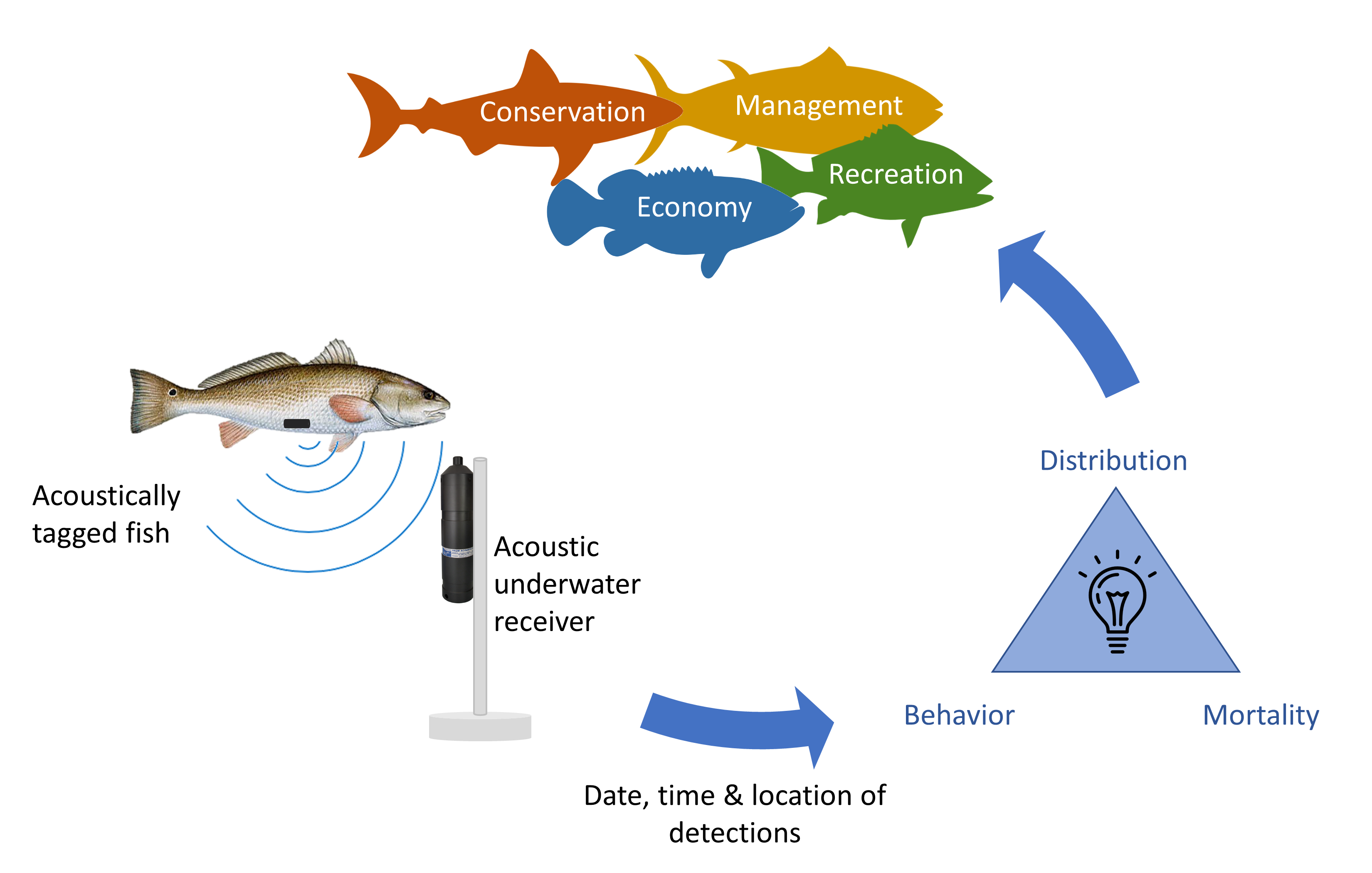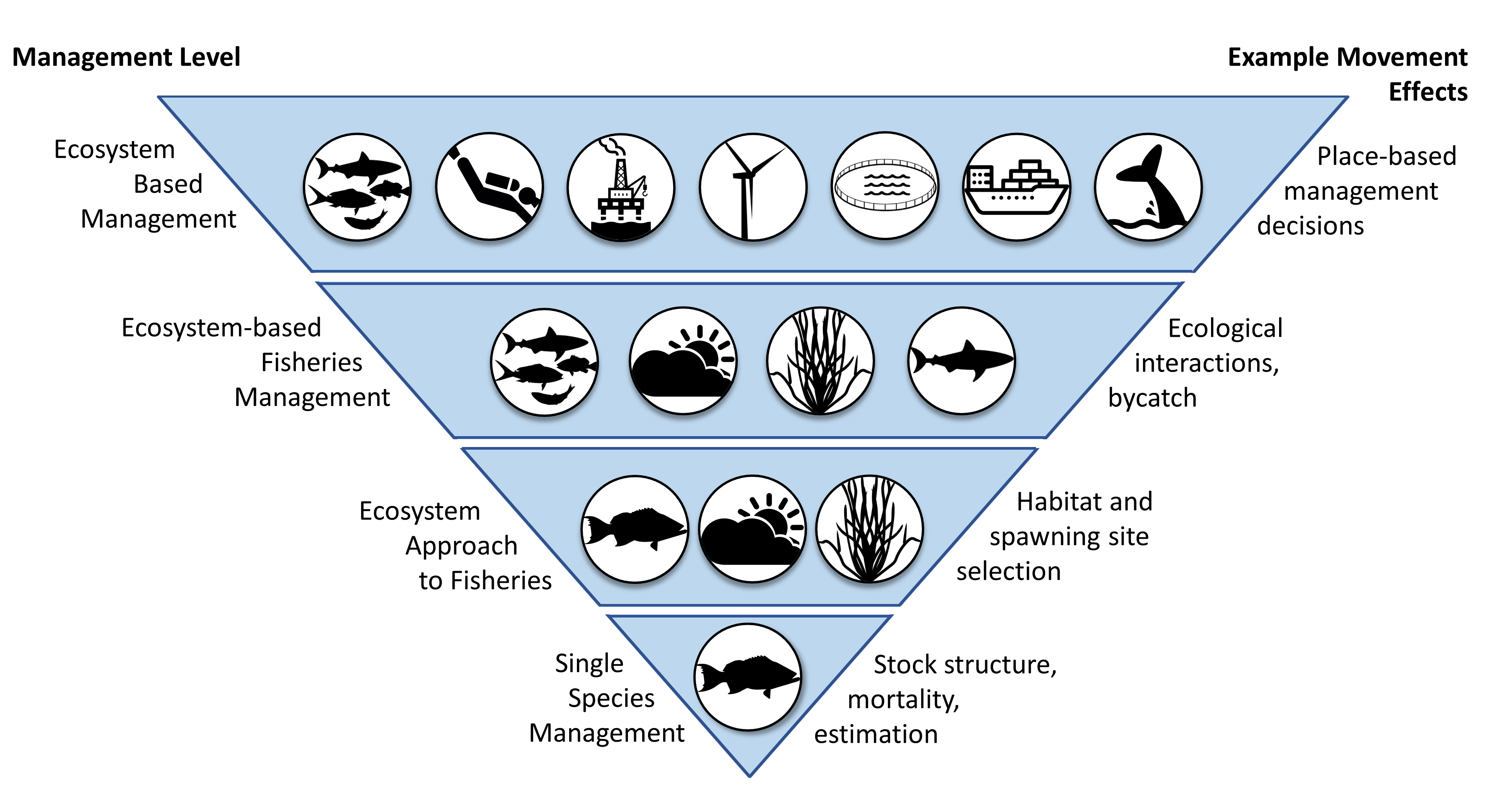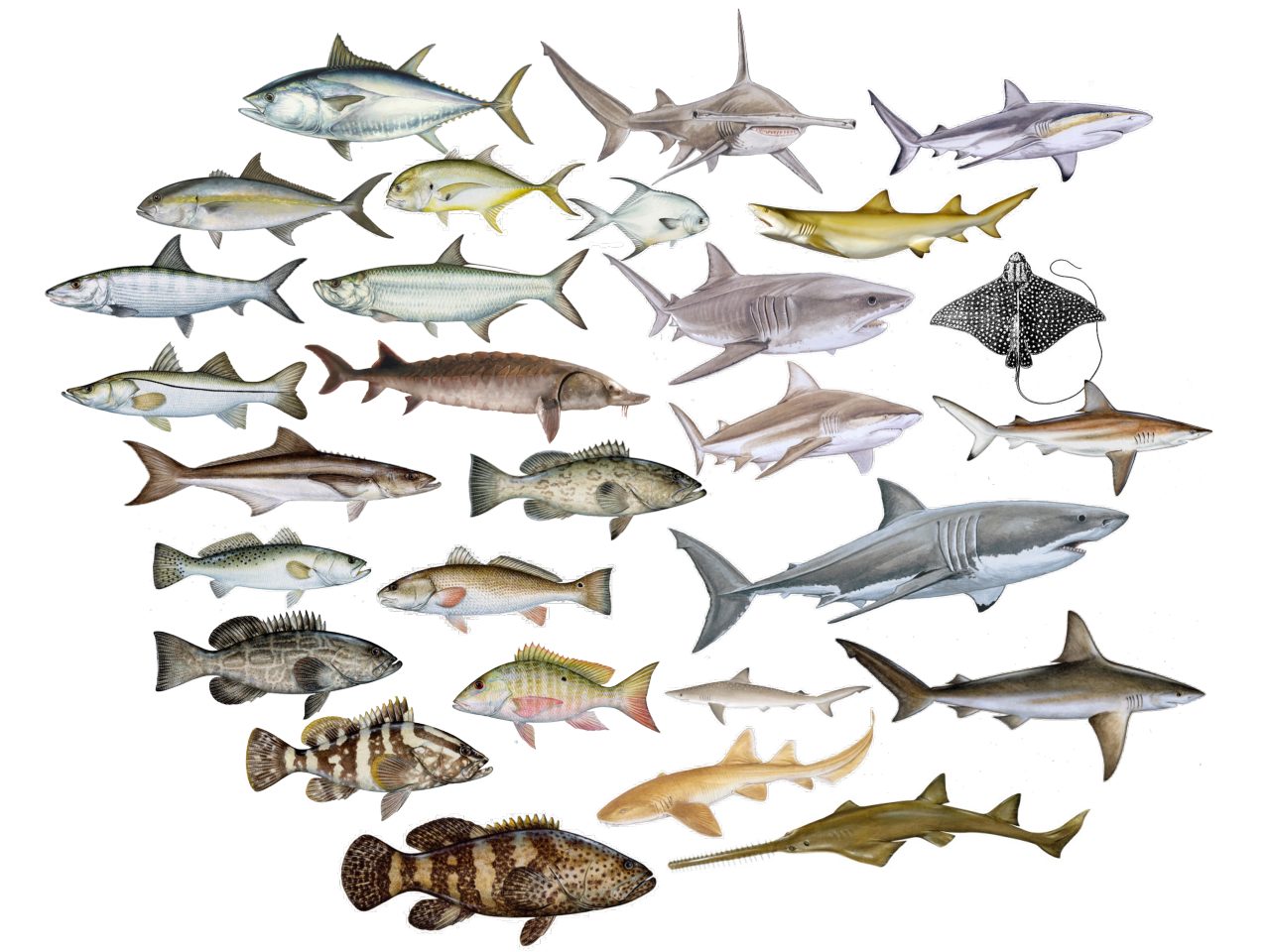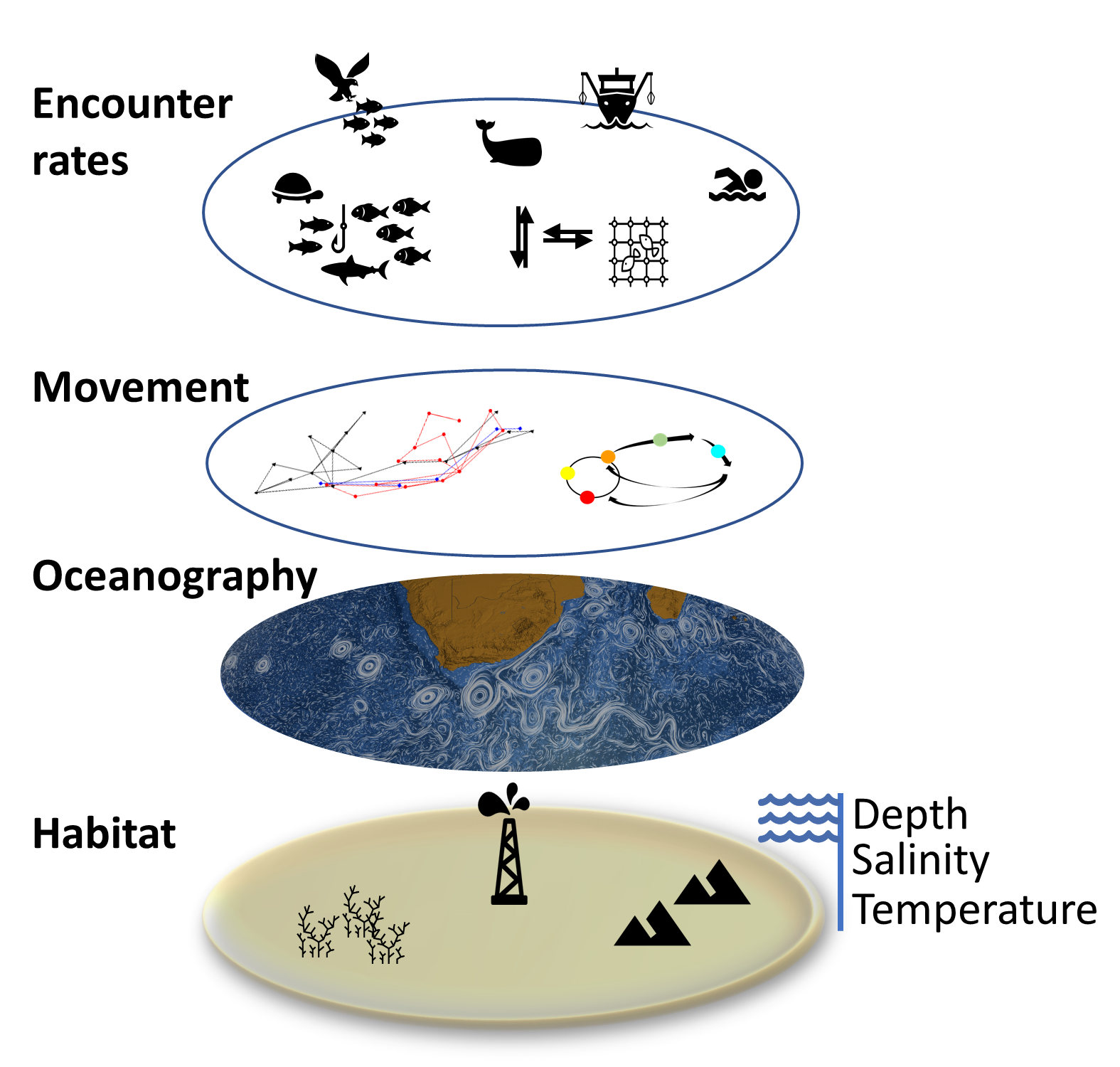Linking Movement and Management
iTAG is committed to facilitating the integration of data and disparate expertise to improve our understanding of the causes and consequences of movement to management and conservation. Given that acoustic tracking is the primary method of tracking animals which remain submerged, the initial focus of iTAG has been primarily on fish and how movement can improve our understanding of fisheries science and management. Although movement has always played an important role in fisheries science, movement patterns are changing with changing ocean conditions affecting availability to capture, the spatial scale of needed governance, and our food supply. Because movement determines where a fish is in space and time it affects all levels of fisheries management, from traditional single species stock assessments to ecosystem-based approaches (Lowerre-Barbieri et al., 2019).


As fish change their distributions they may no longer be effectively sampled by surveys designed to sample their prior high-use habitat affecting our ability to estimate abundance. Tracking data is also one of the few ways to assess mortality and help decrease by-catch (Hazen et al., 2018) and discard mortality and improve spatial management. This data is also critical to understand ecosystem service transfers and biodiversity hotspots.
iTAG’s Orphan Exchange
The orphan data exchange is a platform that allows array owners to upload tag numbers which were detected in their arrays but do not belong to animals they had tagged. The uploaded “orphan” tag numbers can be viewed by other iTag members, and if a member finds any of their own tagged animals amongst the orphan tags, they “adopt” these and the array owner shares the detection data. This “connects the dots” in terms of movement but also connects these scientists, building opportunities for collaboration.

Fish image credits: Diane Peebles, NOAA, Pencil Sessions, Marc Dando, King Sailfish Mounts, Fishwatch.gov, Oregon Coast Aquarium
The image below shows the number of tags, by species, that have been adopted through iTAG.

Linkages
For bio-logging data to inform management in the next decade, we need to develop scientific platforms that synthesize or increase the scale of tracking data, as well as bring together ecologists and assessment scientists. Obtaining movement data for animals at the Large Marine Ecosystem scale that can inform population models is challenging due to technological limitations and cost of doing so. Current efforts to solve this issue include the synthesis of tracks from archival tags across studies or building acoustic telemetry networks to share data across receiver arrays. There are also many efforts underway to consolidate movement data on large marine megafauna, link movement across marine, terrestrial, and aerial realms, and train researchers novel methods for analyzing movement data.

Movement determines encounter rates affecting:
mortality, reproductive success, catch per unit effort, and by-catch and ecosystem services

This concept is driving new models of management, such as dynamic ocean management, defined as the use of near real-time biological, oceanographic, social and/or economic data for management occurring at shorter spatio-temporal scales—more in sync with the resources being managed (Lewison et al., 2015).
An example of using tracking data to help move toward dynamic ocean management is Hazen et al., 2018 who develop integrated species-specific probabilities of occurrence for a target species and three high-probability by-catch species. They then use this to develop a single predictive surface, weighing the contribution of each species by management concern. Their results suggest that movement data can be used to develop much smaller dynamic closure areas while still providing needed protection to endangered non-target species.
Examples of iTAG members assessing movement to help inform management:

Red Snapper continues to be overfished in the GOM, despite intense regulation. Curtis et al., 2015 estimated delayed mortality rates caused by barotrauma after the fish is returned to depth using acoustic transmitters with acceleration and depth sensors. This information is important to management because discard mortality rates impact stock assessment results and estimates of rebuilding rates.
Jackson et al., 2018 used a combination of acoustic monitoring via subsurface hydrophone arrays and pop-up satellite archival tags to estimate release mortality for greater amberjack. Greater amberjack are currently designated as overfished, and the fishery is dominated by the recreational sector, with 75% of the catch in that sector being regulatory discards. The study was able to validate release mortality estimates used in the most recent stock assessment.

Understanding reproductive behavior & vulnerability to fishing
Brownscombe et al. documented a case where the results from acoustic telemetry research were swiftly and directly incorporated into recreational fisheries regulations for permit in the Gulf of Mexico. Telemetry data showed that permit spawning aggregations occurred earlier in the year than previously believed, resulting in an expansion of the existing spawning closure.


Lowerre-Barbieri et al., 2016 investigated reproductive behavior of red drum in the Tampa Bay and Charlotte Harbor areas. They acoustically tagged subadults in the Tampa Bay estuary and adults at the offshore spawning aggregations. They found that subadults recruited to the offshore spawning area before, during, and after the spawning season. Compared to the adults, first time spawners arrived at the spawning site later in subsequent years and spent less time there.
Integrated with other methods to improve estimates of abundance
Lowerre-Barbieri et al., 2018 characterized red drum spawning aggregations off Tampa Bay and Charlotte Harbor in Florida using a combination of acoustic telemetry and genetic mark-recapture. Their study employed multiple sampling methods, including aerial surveys and purse seine sampling. They found interannual differences in spawning site use and high spawning site fidelity.


Spatial scale of needed governance
A study by Rooker et al., 2019 highlights the need for trans-national coordination and collaboration in the management of highly migratory species. The study used smart position and archival tags to monitor the position of various shark, tuna, and billfish species and found frequent crossing of national boundaries, especially for species which tended to be found predominantly in oceanic waters off the continental shelf. The figure below from their study show hotspots of exchange for billfishes and tunas (left figure) and sharks (right figure).

